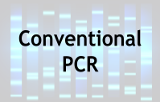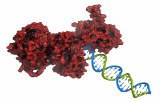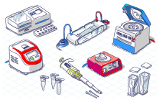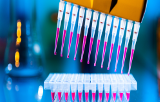
Conventional PCR
A basic PCR set up requires several components and reagents. These components include:
- DNA template that contains the DNA region (target) to amplify
- Taq polymerase, a DNA polymerase that is heat resistant, so that it can remain intact during the DNA denaturation process.
- Two primers that are complementary to the 3' ends of each of the sense and anti-sense strand of the DNA target (DNA polymerase can only bind and elongate from a double-stranded region of DNA, and without primers there is no double-stranded initiation site for polymerase to bind).
- Deoxynucleoside triphosphates (dNTPs, sometimes called "deoxynucleotide triphosphates"; nucleotides containing triphosphate groups), the building-blocks from which the DNA polymerase synthesizes a new DNA strand.
- Buffer solution, providing a suitable chemical environment for optimum activity and stability of the DNA polymerase
- Bivalent cations, magnesium or manganese ions; generally Mg2+ is used, but Mn2+ can be used for PCR-mediated DNA mutagenesis, as higher Mn2+ concentration increases the error rate during DNA synthesis
- Monovalent cation potassium ions
 |
Typically, PCR consists
of a series of 20–40 repeated temperature
changes, called cycles, with each cycle commonly consisting of 2–3
discrete temperature steps. The cycling is often preceded by a single
temperature step at a high temperature (>90 °C), and followed by
one
hold at the end for final product extension or brief storage. The
temperatures used and the length of time they are applied in each cycle
depend on a variety of parameters. These include the enzyme used for
DNA synthesis, the concentration of divalent ions and dNTPs in the
reaction, and the melting temperature (Tm) of the primers.
|




